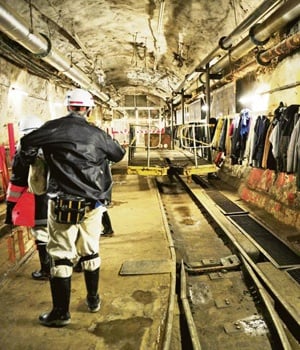
Johannesburg - Thulisile Zweli hoists a 21kg drill to the height of his hip and points its business end at the rock face. Noise explodes inside the cramped cave, overriding all other senses for the minute or so he drives the point of the machine into the wall. When he finally releases the trigger, the lamps on the helmets of his four team members show fresh streams of sweat trickling down his face and arms.
Three and a half kilometres underground and deep into the tunnels of Sibanye Gold’s Hlanganani shaft at its Driefontein mine, it is hot, loud, cramped and dangerous. With the puddles of water, the harsh lighting, the ropes, chains and the almost total absence of colour, the scene is like a postapocalyptic movie set.
Two thousand people are working in the warren of tunnels in Hlanganani alone, but the area is so immense that you only see a handful at a time.
Industry in decline
Most of South Africa’s gold mines are deep, dangerous and increasingly expensive to mine. But there’s still a lot of gold here – geologists estimate reserves of about 6 000 tonnes, making this country the biggest repository of gold after Australia.
Despite this, the production of resources is falling fast. The greatest decline has been in the gold industry, where South Africa has slipped from dominating the global industry to being a bit player. In the 1970s, South Africa produced 80% of the world’s gold. Now it accounts for about just 5%.
“In 1979, we earned $35 billion from gold. Now we barely get $6 billion,” said Peter Major, head of mining at Cadiz Corporate Solutions.
The problem is getting gold out of the ground profitably – and as costs increase and grades shrink, this is becoming less possible, leading analysts to declare that the gold industry in particular is heading into a South African sunset. Some say the end will come in 2021, others say it will be closer to 2030.
Union demands
Some of the biggest impediments to extending the life of mines have been soaring wage demands against collapsing production, increasingly violent strikes, an incomprehensible regulatory environment, and an unpredictable and increasingly expensive power supply.
The weak rand, though, has helped because the metal trades in dollars, while costs are in the local currency.
However, even this fillip is countered by the forces acting against profitability.
James Wellsted, spokesperson for Sibanye Gold, said this week that revenue from the first 20 days of any month goes solely to covering fixed costs. Any work stoppage or strike action slashes revenue production needed both to develop and even sustain the mines.
Unsurprisingly, these issues have sent investors scurrying and have resulted in hundreds of lower-grade mines being shut down. Even the soaring demand for resources at the beginning of the decade did not stem the collapse of the industry – in particular gold mining.
One of the biggest reasons analysts predict gold mining is ending in South Africa is union demands, with the National Union of Mineworkers and the Association of Mineworkers and Construction Union (Amcu) refusing to budge unless a 100% increase – a R12 500 cash component for entry-level mine workers – is granted.
Zweli, who came to Driefontein from the Eastern Cape 12 years ago, says sometimes he works underground for up to 15 hours at a time. The extra hours mean extra cash: “Otherwise I can take home [R6 500] at the end of the month.”
But the cash component amounts to about half his actual wage. The most recent wage offer Sibanye has made to unions guarantees entry-level underground workers R10 026 a month, which is made up of cash, leave pay, a living out allowance, medical insurance and a retirement contribution. By July 2017, the package will be raised to R13 236. Unions and employers have been wrestling over a new three-year pay deal since June.
South Africa’s famous gold industry was built on the backs of labourers who lived in brutal conditions and were treated little better than slaves. One of the most vital changes in the mining environment has been a dramatic improvement of working conditions.
At Sibanye, the grim world under the ground is transformed on the surface. More than R600 million has been spent of housing alone. Accommodation ranges from four-bedroom “hostels” with a common bathroom and kitchen complete with a TV, to two-bedroom private residences. Mine workers have the option to buy their own homes out of the “living out allowance” given each month to workers – like Zweli – who live off the property.
Those who live at the mine get four cooked meals a day, access to sporting facilities, a clinic and adult education, among other things. Married quarters – homes separate from the hostels – are available for workers for one month out of every six to encourage a family connection.
The monstrous debts taken on by many mine workers as a result of loan sharks have also been addressed though debt consolidation and financial literacy schemes.
While imperative, these improvements don’t boost productivity, the main driver of the industry.
Stats SA said gold production from November 2014 to January 2015 was 74.4 compared with 79.1 produced from August 2014 to October 2014. The figures are calculated against an index set to 100 for the base period of 2010.
According to the statistics, South Africa produced 87% less gold in January 2015 than in the same month in 1980. And gold’s contribution to the economy fell from 3.8% of GDP in 1993 to 1.7% in 2013. The metal made up 67% of all mineral sales in 1980, falling to 12.5% in 2014.
About 20% of Sibanye’s fixed costs go to Eskom. At a depth of 3.2km, temperatures reach an impossible 52°C. But a series of massive power-hungry fans keep the air at a maximum temperature of 32°C, albeit with humidity at saturation point. Sibanye needs about 500MW to operate – about one full unit of any of the country’s coal-fired power stations – and a lot of this is used to keep things cool, as well as transport people and haul out hundreds of tons of rock.
It’s because of this that Sibanye is considering seriously moving into the coal sector, which CEO Neal Froneman said would be “in the not too distant future”. He said management would be fired if the mine just continued to rely on Eskom. The initial move away from its dependence on the state power utility will be towards solar power, but then the plan is to set up off-take agreements with independent power producers that would fund and build the power stations. The only debate at this stage is whether to have the coal-fired stations built at Sibanye’s coal mines, or to bring the coal to the power station.
Overheating is just one of a range of potentially deadly situations that can happen under the ground. The pressure of the rock above is about 9 500 tons per square metre, almost 920 times that of normal atmospheric pressure. When rock is removed during the mining process, the pressure trebles in the surrounding rock. Add to the mix the fan-driven cooling, and it’s no surprise that rock bursts are one of the most common causes of death in deep-level mines.
But it is just another potentially deadly day at the office for Zweli, whose grimy white helmet is jammed over long dreadlocks that are wrapped tightly to keep out them out of the way of moving mechanical parts. “It’s very, very dangerous here. You can die any time,” he says.
Safety is a concept worked into every part of the underground operations. Reminders are everywhere – on walls, overalls and every type of machinery. Detailed discussions about conditions are held before any task is taken on, and mine workers – at every level – are urged to pull out if they see any potential red flags. Safe zones are carefully marked out at various points along the tunnels. These reinforced rooms seal off toxic fumes and are stocked with oxygen, water and a hotline to the surface. There’s no food, though – apparently a person can survive weeks without it. Still, the danger is inherent – last year, there were 12 fatalities; in 2013, there were nine.
While strike action and a two-day underground sit-in this month by about 1 000 members of Amcu have been hot topics, there is no sign of anger underground. Zweli says he and his team are all Amcu members and they want a R12 500 minimum wage.




 Publications
Publications
 Partners
Partners








